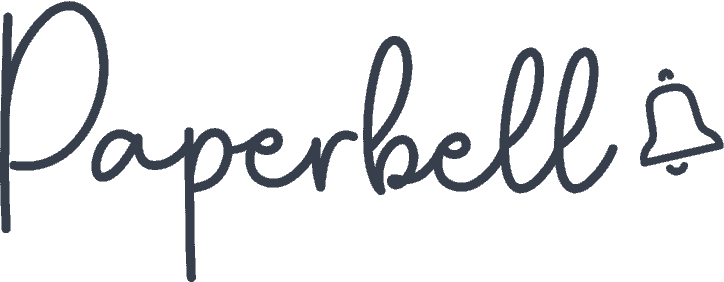If we’re being honest, pricing your coaching services can feel paralyzing.
You’ve spent months (maybe even years) getting certified, developing your coaching skills, and figuring out exactly how you want to help people. But when it comes time to put a price tag on your coaching? Suddenly, you’re second-guessing everything.
What if you charge too much and no one buys? What if you charge too little and can’t pay your bills? What if someone asks why you’re “so expensive”?
The thing is, pricing doesn’t have to be this complicated. You don’t need a degree in economics or a crystal ball to set coaching prices that feel good and work for your business.
In this post, you’ll learn how to price your coaching services in a way that makes sense for where you are right now, including:
- Types of coaching services
- Types of pricing for coaching services
- Factors that affect pricing
- The simple pricing strategy to get you started
- How Paperbell makes pricing easier
Types of Coaching Services
Before we dive into pricing strategies, let’s quickly cover the different types of coaching services you can offer. How you structure your coaching directly impacts how you should price it.
- One-on-one coaching sessions: Individual sessions where you work with clients privately. These can be standalone sessions or part of a larger package.
- Coaching packages: Bundled sessions over a set timeframe (like a 3-month coaching package or 6-month program). This is the most common structure for sustainable coaching businesses.
- Group coaching programs: Working with multiple clients simultaneously, often combining group calls with individual support.
- Subscription/ongoing coaching: Clients pay monthly for continued access to your coaching, without a defined end date.
- Coaching memberships: Similar to subscriptions but often include community access, resources, and regular group sessions.
- Voxer coaching: Asynchronous voice message coaching through apps like Voxer, offering flexibility without scheduled calls.
- VIP intensive days: Condensed, high-touch coaching experiences where you work intensively with a client over a single day or weekend.
The type of service you offer changes everything about your pricing strategy. For example, hourly sessions require constant client acquisition, while a 6-month package gives you predictable revenue and deeper client relationships.
Most coaches find the sweet spot with coaching package pricing because it allows you to focus on transformation rather than trading time for money.
Types of Pricing for Coaching Services
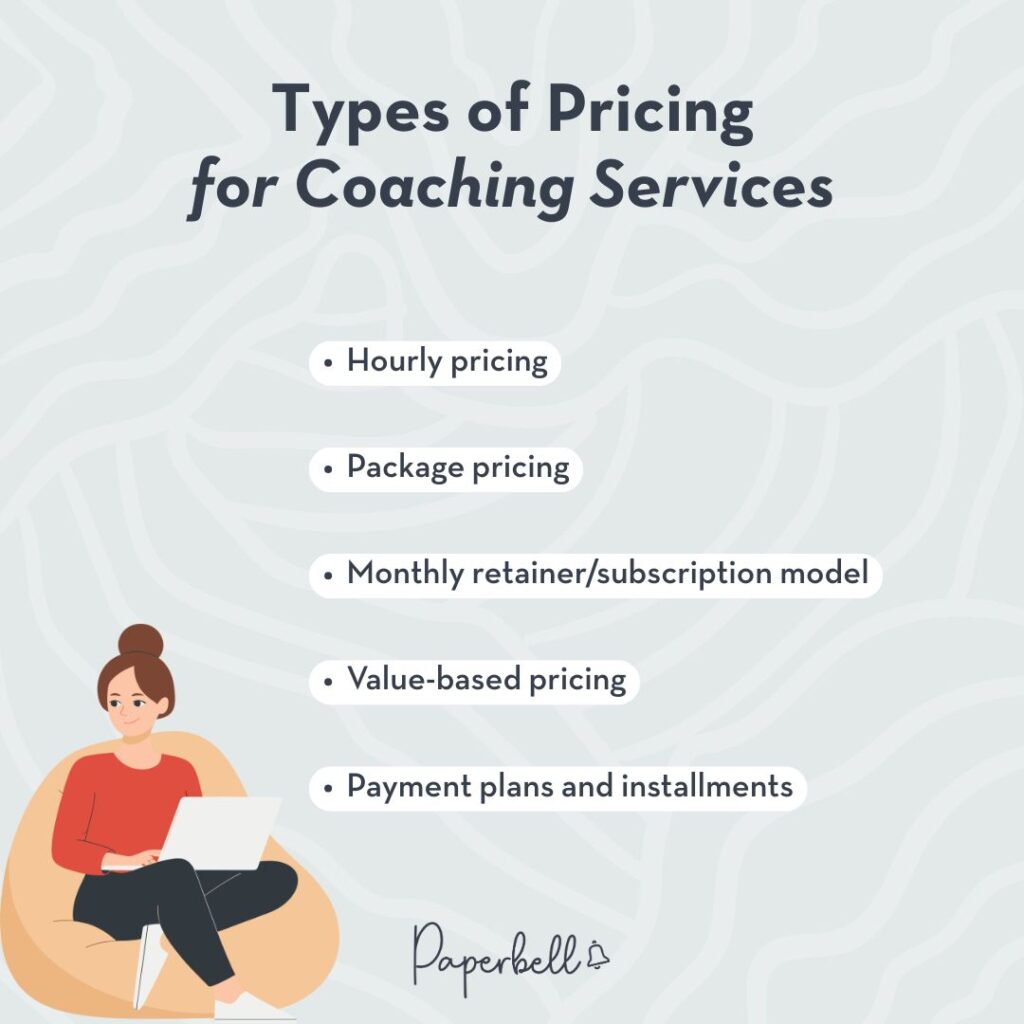
Now that you know what you’re selling, let’s talk about how to price it.
1. Hourly pricing (and why most coaches should avoid it)
Charging by the hour seems straightforward, but it creates problems fast:
- It caps your income at the number of hours you can physically work.
- It penalizes you for getting better at your job (the more efficient and skilled you become, the less time sessions take, which means you actually earn less for delivering better results).
- It keeps clients focused on the clock instead of their transformation.
If you’re brand new to coaching and want to test the waters, hourly pricing can work temporarily. But plan to move away from it as quickly as possible.
2. Package pricing (recommended for most coaches)
This is where most successful coaches land, and for good reason.
Package pricing bundles multiple sessions together over a set timeframe. Instead of charging $150 per session, you might charge $1,500 for a 3-month package that includes 6 sessions plus email support.
Or, for shorter packages, you could charge between $500 and $800, like River and Reed Coaching’s 4-week package:
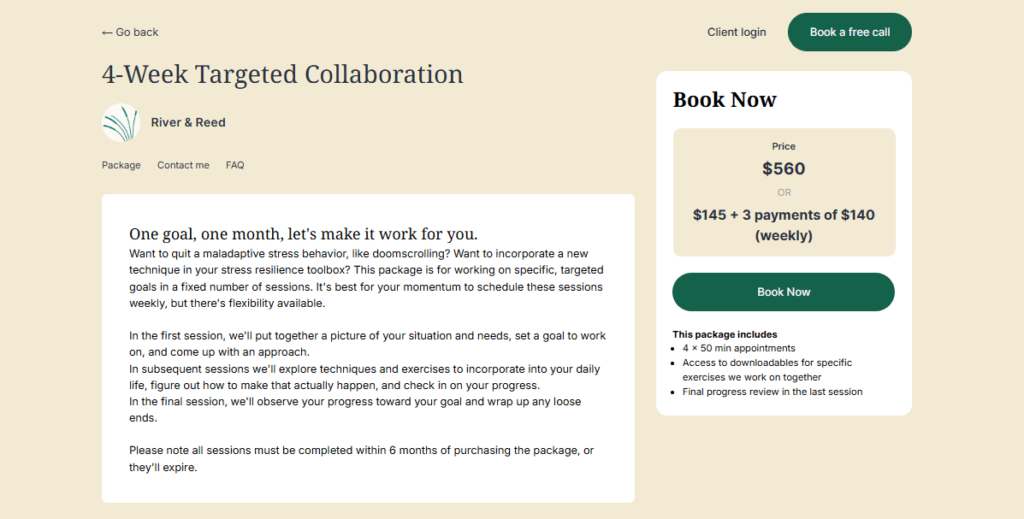
Those are just a few examples. And doing this this way offers several benefits for both you and your clients, such as:
- Clients commit to the full transformation, not just one conversation.
- You can structure the journey properly instead of hoping they book another session.
- You get paid upfront (or through payment plans), which creates cash flow stability.
- You can price based on the value of the transformation, not just your time.
Package pricing also makes your offers clearer and easier to sell. Instead of “let’s meet and see what happens,” you’re offering a defined journey with a clear outcome.
Pro tip: Paperbell makes it incredibly simple to set up coaching packages with flexible payment options. Try it out for yourself today.
3. Monthly retainer/subscription model
With this model, clients pay a recurring monthly fee for ongoing access to your coaching. This works well if you’re offering continuous support rather than a transformation with a clear endpoint.
The advantage is predictable recurring revenue. The challenge is that without a defined end date, some clients stay longer than they need to, while others leave before getting results.
This model works best when paired with memberships or group programs where clients are getting ongoing value beyond one-on-one time with you.
4. Value-based pricing
Value-based pricing means you set your rates based on the transformation you provide, not the time it takes you to deliver it.
For example, let’s say you’re a small business coach, and you help entrepreneurs add $50,000 in revenue to their business. Charging $5,000 for that transformation is more than fair, even if the actual coaching only takes 10 hours of your time.
This is the model that allows coaches to earn well without working around the clock. But it requires confidence in your ability to deliver results and the willingness (and skill!) to articulate that value clearly to potential clients.
5. Payment plans and installments
Instead of requiring $3,000 upfront for a 6-month package, you might offer $500 per month for 6 months. This makes your coaching accessible to more people while still getting you paid fairly for your work.
You can also offer a small discount for paying in full upfront, which incentivizes clients who can afford it to pay the full amount immediately.
Paperbell handles all of this automatically, so you’re not manually tracking who owes what or sending awkward payment reminders.
Factors that Affect Pricing Strategy
Pricing isn’t one-size-fits-all. What works for one coach might not work for another, even in the same niche. Here are the biggest factors that should influence your rates.
1. Your experience level and credentials
Let’s look at a real example: Brigid Tebaldi, a National Board Certified Health & Wellness Coach, offers her Restored by Grace program for $1,500.
This 12-week program helps moms heal after birth trauma and includes:
- Twice-monthly 60-minute group sessions
- On-demand coaching support
- Access to her complete curriculum
- And much more
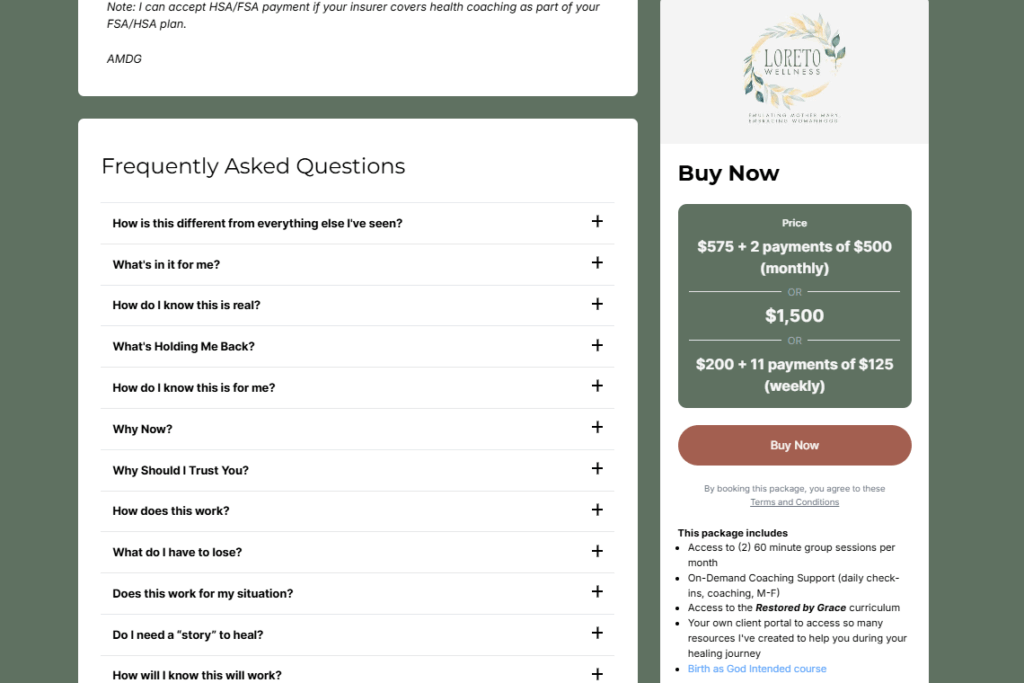
Brigid can charge this rate for group sessions because she has a specific signature coaching program that solves a clear problem. She also has testimonials from past clients and recognized certifications that build trust with potential clients.
If you’re newer to coaching and don’t yet have testimonials or credentials, you might start at a lower rate while you build your portfolio. That’s completely normal and expected.
2. Your niche and target market
Who you serve and what you help them with dramatically impacts what you can charge.
Executive coaches working with corporate leaders can charge significantly more than life coaches working with college students. That doesn’t mean one is “better” than the other. It’s simply a reflection of what those markets can afford and the different value propositions.
If your ideal clients are busy professionals who value their time highly, they’ll often pay premium rates for coaching that saves them years of trial and error.
3. Geographic location and target audience income
If you’re coaching online, geography matters less than it used to. But if your target audience lives in an area with a lower cost of living, they may have different budget expectations than clients in expensive cities.
This is another reason to think carefully about who you want to serve. Your coaching niche determines not just what you teach, but also what you can realistically charge.
4. The transformation you provide (not just your time)
Here’s another real example: Coach Chinonyelum Udoye charges $3,570 for her 6-month private coaching program.
She’s not just selling 22 coaching sessions. She’s helping women stop people-pleasing and lead from alignment.
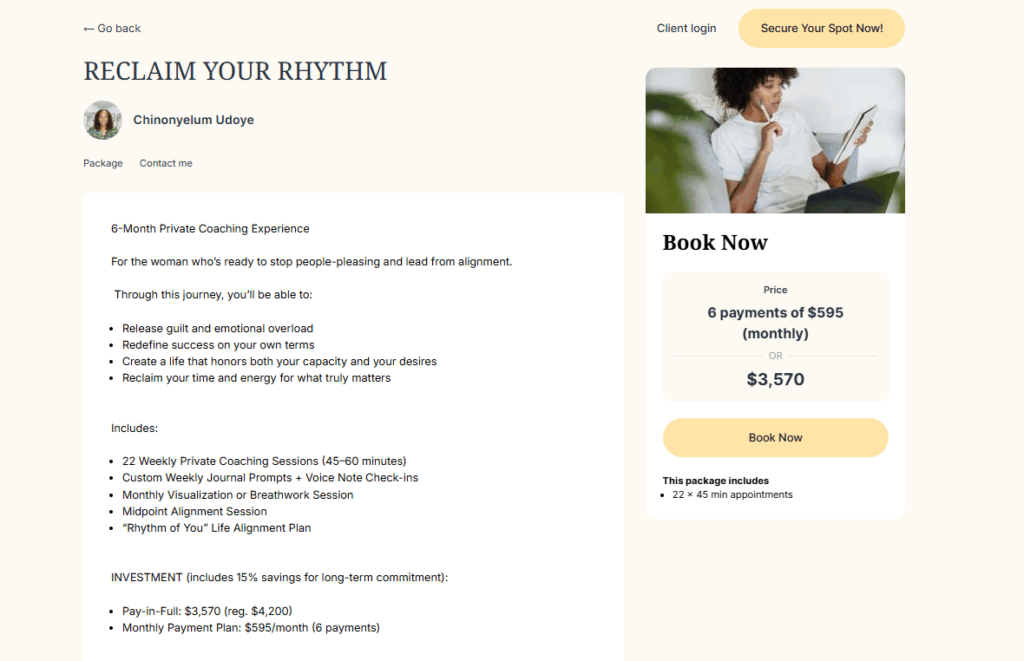
Her package offers a complete transformation that includes:
- Releasing guilt
- Redefining success
- Reclaiming time and energy
- Strengthening their professional presence
- Setting boundaries with confidence
- Leading with authenticity
When you frame your coaching around the transformation instead of the time commitment, pricing becomes clearer. You’re not charging for 45-minute sessions. You’re charging for a different life.
4. Market rates in your coaching specialty
You don’t have to match what other coaches charge, but you should know what’s typical in your niche.
Are similar coaches charging $2,000 for 3-month packages? Or are they closer to $5,000?
Understanding the range helps you position yourself appropriately based on your experience and the value you deliver.
Want to see real pricing examples from actual coaches? Download this free report to see how 28 real coaches price their packages across different niches and experience levels.
5. Your business goals and desired income
This one’s practical but often overlooked.
If you need to make $5,000 per month to cover your expenses and you can realistically take on five clients at a time, you need to charge at least $1,000 per client.
If you want to work with only three clients at a time, you need to charge closer to $1,667 per client.
Working backward from your income goals helps you set rates that actually support the business you’re trying to build.
6. Confidence level (and how it grows with experience)
When I first started offering coaching and consulting, I charged $97 for an hour-long strategy session.
Was I worth more than that? Probably. But I had no experience actually coaching (plenty of experience on the topic I was coaching about). I had no coaching-specific testimonials, and frankly, I just wanted someone to say yes.
I needed the cash flow and the practice.
Since then, I’ve more than doubled my strategy session pricing. I also only take coaching or consulting clients when I’m confident they’re a good fit and I’ll genuinely enjoy working with them.
I’ve even expanded into asynchronous coaching and charged $1,200 for a 6-week coaching package with no calls at all. That only works because I’m confident in my ability to deliver results that way.
Your confidence will grow as you get results for clients. In the beginning, it’s okay to charge less while you build that confidence.
Just don’t stay there longer than necessary.
The Simple Strategy to Get You Started With Your Coaching Service Prices
If you’re feeling overwhelmed by all these factors, here’s a simple 3-phase approach that takes the guesswork out of pricing.
Phase 1: Penetration pricing
When you’re just starting out, use penetration pricing to get your first clients in the door and build testimonials.
At this phase, your goal isn’t to make tons of money. It’s to:
- Get experience
- Refine your process
- Collect testimonials that will help you raise your rates later
A good baseline is around $1,500 for a 3-month coaching package. This positions you as a professional (not a hobbyist), but it’s accessible enough that people will take a chance on you even without a long track record.
Phase 2: Necessity pricing
Once you have a few clients under your belt and some solid testimonials, move to necessity pricing.
This means charging enough to cover your actual business costs and pay yourself a reasonable salary:
- Calculate what you need to make per month
- Factor in how many clients you can realistically serve
- Set your prices accordingly
If you need $6,000 per month and can work with 6 clients, you need to charge at least $1,000 per client. If you can only manage 3 clients at a time while maintaining quality, you need to charge $2,000 per client.
This phase helps you build a sustainable business that doesn’t burn you out or leave you broke.
Phase 3: Premium pricing
Finally, once you’re confident in your results and have a strong reputation, move to premium pricing.
Premium pricing means charging what your transformation is actually worth in someone’s life or business.
If you help someone double their income, overcome a decade of limiting beliefs, or completely transform their relationship with their body, that’s worth a premium investment.
At this phase, you’re not competing on price. You’re competing on results, and clients who are serious about transformation will pay accordingly.
You might charge $5,000, $10,000, or even more for deep transformational work. The key is that you can back it up with proven results and a clear process for getting clients there.
How Paperbell Makes Pricing Easier
Once you’ve decided on your pricing strategy, the next step is actually setting it up so clients can easily buy from you.
This is where a lot of coaches get stuck again. Do you need a website? A payment processor? A scheduling tool? How do you make it easy for someone to say yes without overwhelming them with tech?
Paperbell handles all of this in one place.
You can set up beautiful coaching package pages with flexible pricing options, such as:
- Pay-in-full
- Monthly payment plans
- Custom installment schedules
- Monthly subscriptions
Everything is branded to you, and payment processing happens automatically through Stripe or PayPal.
Even better, it takes just minutes to set up your first package. You can even pick from one of several templates and customize from there:
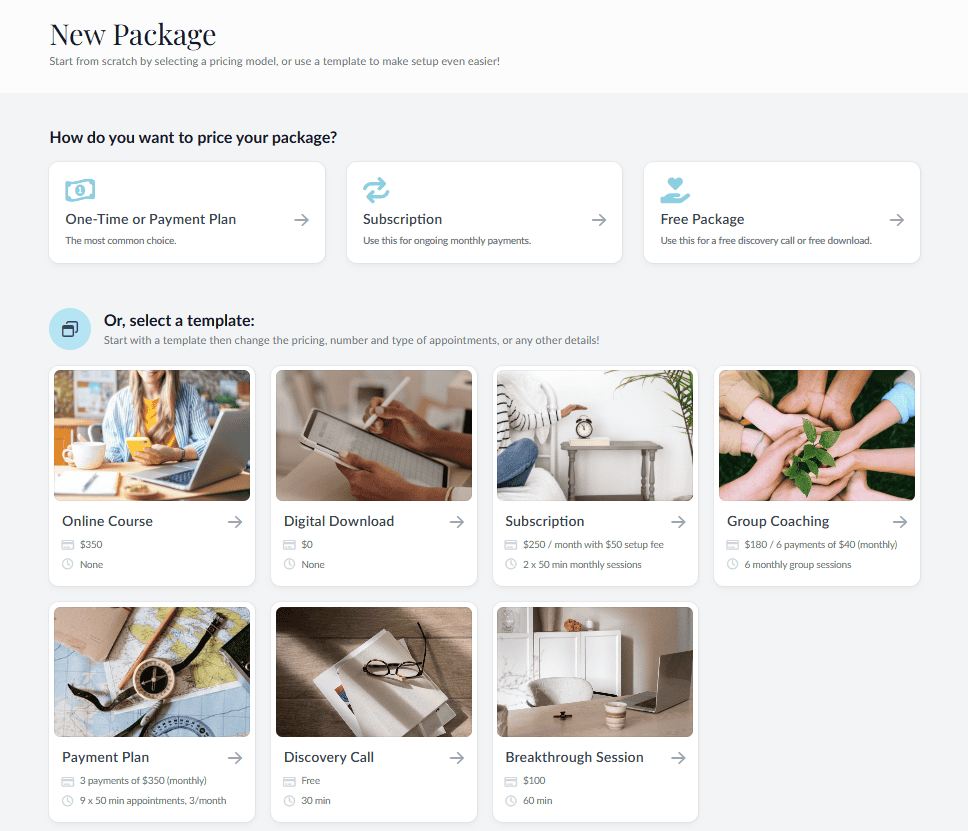
When pricing feels overwhelming, having the tech side handled makes everything easier. You can:
- Test different pricing models
- Adjust as you grow
- Focus on the actual coaching instead of chasing payments or managing spreadsheets
Try it out for free to launch your first coaching package today.
Price With Confidence and Get Back to Coaching
Pricing your coaching services doesn’t have to keep you up at night.
Start with a simple baseline that reflects where you are right now. Get some clients, deliver amazing results, and raise your rates as your confidence grows. Focus on the transformation you provide instead of just the time you spend, and don’t be afraid to charge what you’re worth.
And when you’re ready to make the tech side simple, try Paperbell for free. You’ll have your coaching packages and pricing page set up and ready to sell in minutes, so you can spend less time worrying about pricing and more time actually coaching.
FAQ About Pricing Your Coaching Services
How much should you charge for a coaching session?
For individual sessions, many coaches charge between $100 and $300 per hour, depending on experience and niche. However, most successful coaches move away from hourly pricing toward packages.
How do you price yourself as a coach?
Start by considering your experience level, the transformation you provide, and your income goals. New coaches often begin around $1,500 for a 3-month package, while experienced coaches may charge $3,000 to $10,000 or more.
How to charge clients for coaching?
Most coaches use package pricing with payment plans when setting coaching fees. Clients can pay in full up front or spread payments over several months. Automated tools like Paperbell handle payment processing seamlessly.
What is the average price for coaching?
Life coaching packages typically range from $1,500 to $5,000 for 3-month programs, though rates vary widely based on niche, experience, and target market. Executive coaching or business coaching will often be pricier.
Which tool can I use to help with processing payments easily?
Paperbell is specifically designed for coaches and includes payment processing, scheduling, contracts, and client management in one simple platform. You can set up coaching pricing packages with flexible payment options in minutes.

